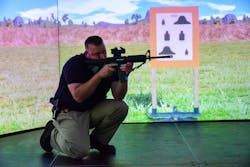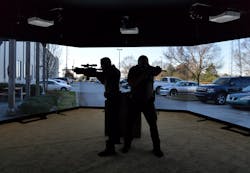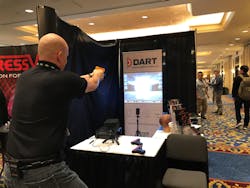For the last few decades, law enforcement has been using simulation for training purposes. Early forms of simulation training put officers in front of a screen in simple “shoot/don’t shoot” scenarios. In the past, someone on a screen would pull a phone out of their pocket or a beer can from behind their back and an officer (the trainee) would have to decide, Do I shoot or do I not shoot? While the simulations were cutting edge for their time, as technology evolved, so did the training capabilities and the scenarios offered. While the systems of the past did not engage the officer fully or train to the various outcomes possible, the systems of today are not what they were 20 years ago.
Today’s virtual reality simulation systems are immersive and include scenarios that have a high level of sensory stimuli. Many systems produce an artificial, sufficiently life-like environment. Virtual reality training can help sharpen marksmanship skills, trigger control and sight picture; it offers judgmental training through life-like scenarios which have a multitude of outcomes based on a trainee’s actions; and many systems come with “after-action” reviews. Virtual reality simulators can prepare new LEOs for patrol and sharpen the skills of veteran officers in a controlled environment.
Train in a controlled setting
Virtual reality simulators are a tool that can be used in many different ways, especially for training law enforcement. First, they provide a space for LEOs to practice their marksmanship in a controlled environment, which can be particularly useful for new recruits who have never had experience with shooting a firearm, says Dave Nielsen, vice president sales at DART Range. It can be also be useful for veteran LEOs who can’t or don’t often make it to the range, helping to build muscle memory.
Beyond marksmanship, however, virtual reality simulations also can include judgmental training. “Once we transition from marksmanship to more of the judgment and decision-making training, we get into an area where the video itself should be begging the question to the trainee, What are you going to do?” says Chuck Deakins, a retired law enforcement officer from Santa Ana, Calif., and current specialist with FAAC, Inc. (parent company of MILO Range). Deakins has been involved in the CaPOST Regional Skills Training Centers program—which has 108 driving simulators and 24 force-option simulators—for nearly 20 years. “It’s easy to put someone in front of the screen and give them a “shoot/don’t shoot” scenario. If you want to take it to the higher level, put at 14-year-old on the screen, have him pull a gun and then have the trainee decide whether they are going to shoot or not shoot. Now you’re getting into the area of judgment.”
Ken Wallentine, a Special Agent with the Utah Attorney General’s Office and a 36-year law enforcement professional, says his training center uses a virtual reality simulator for all of the traditional purposes of training, such as teaching tactics, marksmanship and decision making—but they also use the system to teach legal training and de-escalation techniques. “We teach the skills in a classroom environment first, and then we immerse them into a complete sensory experience in a VR scenario where there are so many different outcomes. The outcomes can include no injury and no force whatsoever,” says Wallentine. “It’s a very holistic approach to training officers in a critical skill.”
Today’s virtual reality simulations also include technology that creates stress for trainees, an important factor in training. “It’s important to put an officer under stress before you put them in the field so that’s not the first place they are experiencing it,” says Jason Mulcahy, general manager at VirTra.
It’s not just helpful for trainees, says Mulcahy. “We had one veteran officer go through our simulator and in one scenario they shot a non-threatening high school kid. When we did an after-action review, the officer was determined that he did not shoot the kid, but we were able to show him that not only did he shoot the kid, he shot him twice.” When officers are surrounded and immersed in scenarios, they have to use their situational awareness now—it’s no longer a shoot/don’t shoot experience in simulation scenarios.
Because virtual reality simulations need to be realistic, Mulcahy points to VirTra’s Threat-Fire device which is attached to a trainee. During simulations, the device can send shocks to the trainee, forcing them to fight through ‘injury’. “We use stress rate monitors and build stress so that in the simulated environment we try to make it as realistic as possible,” he says.
Though there are many benefits of virtual simulation training, one of the most important is in the after-action review, also known as the debriefing, says Michael Paulk, director of virtual systems at Meggitt Training Systems.
In fact, an after-action review is where the learning occurs says FAAC’s Deakins. “You get to see yourself as you performed and of course we are all really good at first, until we watch things back on video and that’s the benefit of the simulator. You get the replay on the video so there is no denial. You can ‘Monday Morning Quarterback’ yourself in a safe environment where, if you need adjustment on your judgment or on your decision-making, you can do it in that room, versus in the field.”
The common analogy used when describing the importance of an “after-action review” is that of a professional athlete. When an athlete goes to work, their training is videotaped and coaches can critique form and review data such as heart rate, power output and more. There’s a science to training. “But in law enforcement, we all seem to think we’re good and that we don’t need coaching,” says Deakins. “The after-action reviews tell us otherwise.”
He points to a controversy he often hears. “When both law enforcement trainers and trainees see a force-option simulator sometimes they’ll say, ‘Well I like simunitions, I want real actors because that makes it much more real,” says Deakins. “For some reason in law enforcement we have a paradigm that says ‘hands on is always the best.’ We have those who think that if they can get out there and drive the real car or shoot back and forth at each other, then that’s the best training option. While it might be the most exciting or the most entertaining, it’s not the best learning methodology that we have available.”
While Deakins does admit that simunitions training is important and valuable, it’s difficult to do a replay and show the trainees exactly what they did. “With virtual simulation training, trainers can go back and see where your game is weak, where your game could be improved and where your game is very strong,” he says.
Attitude changes the training experience
Despite the benefits of virtual simulation training, there is still a lot of criticism on the subject. One of the criticisms Deakins often hears is that “it’s not real.” “I have found through the training experience, that’s usually the defense of the officer who does not want to be coached and who does not want to expose themselves in front of everyone,” says Deakins. “They say the scenarios don’t feel real, that it’s not really their gun or their car or their equipment, and as an instructor it’s our obligation to get them to engage. The first thing I generally do in those situations is get them to use a radio and start talking. A good instructor can get officers to engage.”
But another criticism comes in the form of scenarios offered in systems. Though many of the systems available today offer hundreds of training scenarios with dozens of outcomes depending on an officer’s actions during the scenario, trainees sometimes claim to have memorized all of the scenarios. To that point Deakins says the trainee has become complacent, something that happens in daily patrol life. “Complacency happens in our cities because everyday we come out of our police station, we turn right, we drive down the street, we get to a controlled intersection and we drive through and forget to check the intersection.” Deakins, at that point, tells the trainers it’s time to switch up scenarios or build new ones. “I tell trainers to train to the criticism. Criticism is an opportunity to do better training. If the trainee is used to seeing a green car come to a stop in a driving simulator scenario, we’ll change something in the next scenario and hopefully that will enlighten the trainee to recognize their complacency and the consequences of it.”
The cost of the solutions
When choosing a system of your own, cost is of large concern for many law enforcement agencies, says DART Range’s Nielsen. “Price is a constant lament from law enforcement, but a quality simulator can be fairly and affordably priced,” he says.Wallentine notes that agencies should first assess their needs when choosing a virtual simulator. The VirTra system offered at the Utah Attorney General’s Office is a service provided by the Office for all state, local and federal law enforcement officers in the state of Utah. However, that is not the norm. “Many agencies will see the prices of some of these systems and think ‘I can’t afford that’, which is why it’s important to know how you would use the system.”
Wallentine says he could see higher-cost systems as a good fit for regional training centers and/or police academies. Though the cost of virtual simulators may be a detractor for some law enforcement agencies, it doesn’t have to be. Agencies can get creative. “I’m aware of one instance where 15 or 16 agencies came together and contributed funding and volunteer staff time to run a virtual reality center,” Wallentine notes. Law enforcement can also lobby for systems. “Arizona’s legislature thought VR training was such a high priority that they funded multiple centers spread throughout the state,” he says.
Extend the uses of the system
One misconception about virtual reality simulators is that their only function is for training. Meggitt’s Paulk says that’s not the case. “You can also use the systems in community outreach, taking the training to city council meetings and to events to show your community members,” he says. “Putting community members through a scenario will give them a little idea of what your officers face.”
Wallentine adds that in addition to training, some police departments use the system when it comes to hiring decisions. “One department was down to three applicants for one position, so they put the applicants through scenarios and observed their decision-making under pressure,” he says. They’ve also used it for fitness evaluations and have run educational programs for community leaders and school principals. “It shows them the steps we’re taking to provide their agencies with the most effective law enforcement officers out there on the street.”
Virtual reality simulation is absolutely a viable training option for law enforcement, says Wallentine. “It provides such a robust training environment.” Though cost may be a limitation for some departments, utilizing virtual reality simulators can be beneficial when it comes to helping LEOs improve in marksmanship skills, judgmental, communications and after-action review training.
About the Author

Adrienne Zimmer
Editor
Adrienne Zimmer was the Editor of Law Enforcement Technology magazine, a monthly business-to-business publication that covers technology trends and best practices for public safety managers from 2017 to 2019. LET is part of Officer Media Group, which also publishes Law Enforcement Product News and Officer.com. Adrienne has been in publishing since 2013.



